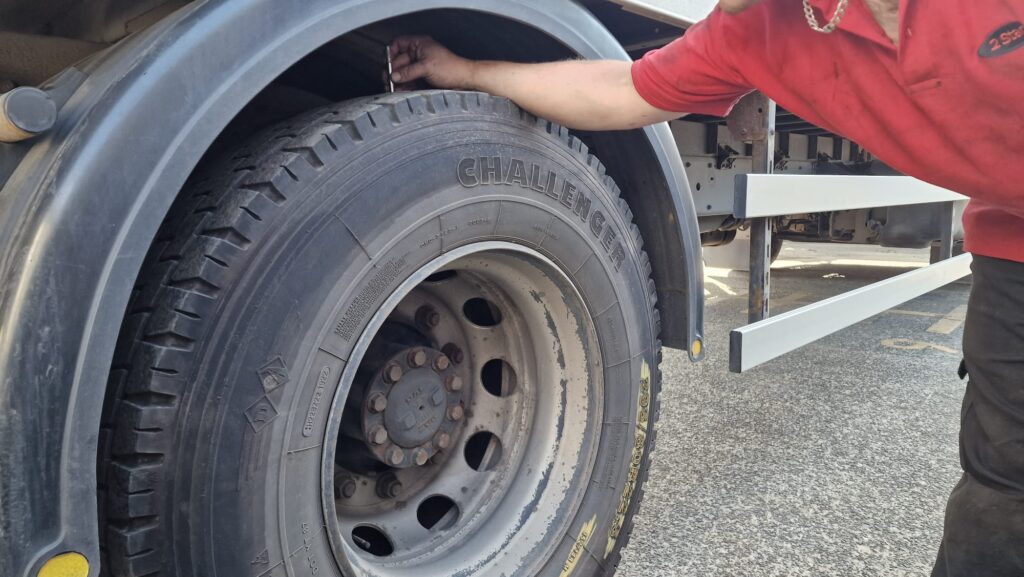When the instructors at 2 Start conduct their Heavy Goods Vehicle (HGV) training course with their student, a core focus is the walkaround checks. This is imperative to the role they will jump into after students pass their test. Vehicle walkaround checks are enforced at all businesses in the logistics sector. This is so before setting off, you can be confident that there are no defects which could hinder the safety of yourself, or put others at risk.
The daily walkaround check covers items which require examining. This involves a comprehensive external and operational check of the vehicle.
We are Wheely Serious About Tyre Safety
Wheels and tyres are just one of the several components in the walkaround check. Tyres on an HGV can affect performance, safety and maintenance costs of the vehicle in question. These components are also critical when it comes to fuel efficiency, especially if you are a long-haul driver, you wouldn’t want a tyre to have a failure mid journey.
Irrespective of a beginner in this bustling industry, or an experienced veteran. It is always insightful and handy to refresh your learning and gain a more holistic understanding as to why tyre maintenance and best practices are vital to your role.

Understanding Tyre Best Practices
With the ban on 10-year-old tyres in 2021, and the prohibited use of Free Rolling Tyres (FRT) on front steering axles in 2023 being implemented, there are already guidelines to support tyre management and best practices. But tyre maintenance is more than these regulations.
The tyres must be able to support the maximum authorised load a vehicle can carry and be able to grip the road for various weather conditions, as well as for long periods of time.
Although there may be several drivers using the same vehicle during a shift, you shouldn’t rely on them to have a similar mindset when it comes to these checks. Nor should it get to the point where you become careless and not note any wear and tear prior to a defect occurring. This is an offence which can affect your vocational entitlement.
Tyre Maintenance
Tyre maintenance and common knowledge go a long way to provide longevity. Thus, reducing costs. Although these costs won’t be on the driver’s head, fleet managers and owners would expect their drivers to make them aware if a part of the vehicle is going to need repairing later on. Not as a defect, but more as a precaution.
Regarding the knowledge of the HGV specifications, enforcing the correct information and guidance is vital to a student’s learning. But we can always go the extra mile and give tips for staying ahead of the curve. Our instructors will give advice and best practice recommendations for maximising the life span of tyres for your commercial vehicle.

No Pressure- Big Problem
Tyre pressures should be checked regularly as part of your companies maintenance system. Also, ensuring your tyres are at the correct PSI increases longevity of other components. This includes axles, suspension and brakes. After all, no one wants to pay additional expenses for repairs due to underinflation.
The less inflated the tyres are, the less economically friendly you will be on the road. This can also make the vehicle more prone to blowouts, swaying, and in more severe cases, rollovers.
It’s All About Balance
In consideration to proper and efficient load distribution, this is imperative to tyre longevity. For example, if the load in your trailer is heavier on one side of the vehicle, one set of tyres will bear a heavier load, causing uneven tread wear.
Tread Carefully!
Tyre tread is another core part of a check which drivers must complete. The tread of a tyre must be even across at least three quarters of the circumference. The minimum limit is 1mm across. Any signs of wear in the tread is normal, but it must be within the regulations enforced by the Driver and Vehicle Standards Agency (DVSA).
Wear is normal, but any abrasions, exposed cords or rips/cuts are more likely to cause damage to the vehicle itself. Having severe uneven wear on your HGV tyres is also a sign that your vehicle could have unaligned wheels. Also, incorrect pressure, or even a sign that your driving type is irregular.

One Size Does Not Fit All
Each vehicle will potentially require different tyre types. This depends on the size and wheel configuration. It can also be impacted by the weather conditions you typically drive in.
Having the most suitable tyres for driving conditions will increase road safety, enhance driving performance, and reduce the risk of losing control of your vehicle. All of these are vital, especially if you are in control of a vehicle carrying hazardous goods.
Nuts About Tyre Safety
Wheel nuts are another factor of these checks. Understanding the correct positions in which all wheel nuts should be, and how to identify if they have moved is a part of your tyre and wheel maintenance checks. Wheel nuts are identified by the fluorescent markers, and they must all point in the correct directions. If one or multiple nuts have been moved, the markers will point in a different direction. However, not all companies use wheel nut markers.
However, the drivers themselves are also a factor for ensuring longevity. Harsh braking and erratic driving behaviour is a cause to shorter tyre lifespan. Of course some situations can’t be helped, such as needing to conduct an emergency stop. But drivers should always keep plenty of space between the HGV and the vehicle in front.
Join The Industry!
When you join the logistics sector as an HGV driver, not only will you be responsible for completing checks at the beginning of each shift, but you will also be responsible for your load, trips and hour regulations (also known as your working time directive).
If you are looking to become an intricate part of the nation’s backbone, and join the fast-paced, exciting logistics sector, then book your HGV course with the logistics training industry leaders. Endorsed by the National Register of LGV Instructors (NRI) and with 6 training depots across the South, we provide driver training courses across Hampshire, Berkshire, Wiltshire and West Sussex. Begin your journey with 2 Start today.










